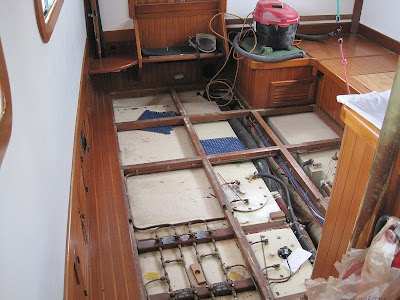Fuel tank replacement project day #1. To help others in the fleet I'll keep track of the labor hours it takes to do this project. The stern two tanks are already empty of fuel. Step one is to pull up the floor boards. I've got a feeling this project will breed many others as all ready I can see that the sound dampening insulation under the floor boards can use some work. Next the floor joists are removed. The Phillips stainless screws holding the joists down strip-out easily. I used a Dremel tool with a small grinding wheel to cut a slot into several of the screws. Two of the joists couldn't be removed at all; one goes under the refrigerator while the other goes under the settee. If necessary they can be cut, but I think the tanks will slide under them. In two places wood blocks were wedged between a joist and a fuel tank. The blocks were of different thicknesses and it appears Ocean Eagle Yachts used these to level out the floor. Fuel lines were removed next.
Some thoughts: The least risk approach for tank replacement is not to start over with a new material and installation method, but to build on the 25+ year history. In fact, by repeating what worked and striving to eliminate the causes of the exterior tank corrosion, there's reason to believe the tanks will last longer than 25 years. Here's how I think our tanks are failing, water leaking by a deck fastener, because the fastener missed the deck batten, is getting beneath the tank and then pooling behind the fiberglass tab holding the tank in place.
2:40 hours labor today and 2:40 hours to date.
 The Multimaster is the right tool to cut the fiberglass away from the tanks.
The Multimaster is the right tool to cut the fiberglass away from the tanks.
 The wet exhaust hose is up tight against the aft starboard tank. It will be disconnected from the muffler and moved out of the way.
The wet exhaust hose is up tight against the aft starboard tank. It will be disconnected from the muffler and moved out of the way.
 Picture of the salon looking aft. All the floor boards are removed and a few of the joists too.
Picture of the salon looking aft. All the floor boards are removed and a few of the joists too.

No comments:
Post a Comment